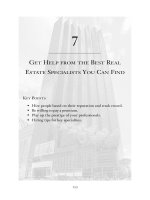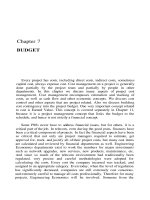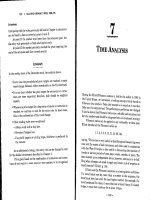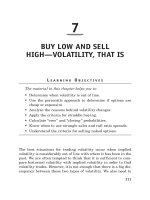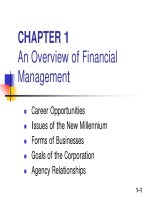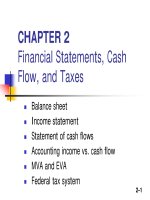Slide Financial Management - Chapter 7 pps
Bạn đang xem bản rút gọn của tài liệu. Xem và tải ngay bản đầy đủ của tài liệu tại đây (175.53 KB, 43 trang )
7-1
CHAPTER 7
Bonds and Their Valuation
Key features of bonds
Bond valuation
Measuring yield
Assessing risk
7-2
What is a bond?
A long-term debt instrument in which
a borrower agrees to make payments
of principal and interest, on specific
dates, to the holders of the bond.
7-3
Bond markets
Primarily traded in the over-the-counter
(OTC) market.
Most bonds are owned by and traded among
large financial institutions.
Full information on bond trades in the OTC
market is not published, but a representative
group of bonds is listed and traded on the
bond division of the NYSE.
7-4
Key Features of a Bond
Par value – face amount of the bond, which
is paid at maturity (assume $1,000).
Coupon interest rate – stated interest rate
(generally fixed) paid by the issuer. Multiply
by par to get dollar payment of interest.
Maturity date – years until the bond must be
repaid.
Issue date – when the bond was issued.
Yield to maturity - rate of return earned on
a bond held until maturity (also called the
“promised yield”).
7-5
Effect of a call provision
Allows issuer to refund the bond issue
if rates decline (helps the issuer, but
hurts the investor).
Borrowers are willing to pay more,
and lenders require more, for callable
bonds.
Most bonds have a deferred call and a
declining call premium.
7-6
What is a sinking fund?
Provision to pay off a loan over its life
rather than all at maturity.
Similar to amortization on a term
loan.
Reduces risk to investor, shortens
average maturity.
But not good for investors if rates
decline after issuance.
7-7
How are sinking funds executed?
Call x% of the issue at par, for sinking
fund purposes.
Likely to be used if k
d
is below the coupon
rate and the bond sells at a premium.
Buy bonds in the open market.
Likely to be used if k
d
is above the coupon
rate and the bond sells at a discount.
7-8
The value of financial assets
n
n
2
2
1
1
k)(1
CF
k)(1
CF
k)(1
CF
Value
+
++
+
+
+
=
0 1 2 n
k
CF
1
CF
n
CF
2
Value
7-9
Other types (features) of bonds
Convertible bond – may be exchanged for
common stock of the firm, at the holder’s
option.
Warrant – long-term option to buy a stated
number of shares of common stock at a
specified price.
Putable bond – allows holder to sell the bond
back to the company prior to maturity.
Income bond – pays interest only when interest
is earned by the firm.
Indexed bond – interest rate paid is based upon
the rate of inflation.
7-10
What is the opportunity cost of
debt capital?
The discount rate (k
i
) is the
opportunity cost of capital, and is the
rate that could be earned on
alternative investments of equal risk.
k
i
= k* + IP + MRP + DRP + LP
7-11
What is the value of a 10-year, 10%
annual coupon bond, if k
d
= 10%?
$1,000 V
$385.54 $38.55 $90.91 V
(1.10)
$1,000
(1.10)
$100
(1.10)
$100
V
B
B
10101
B
=
+++=
+++=
0 1 2 n
k
100
100 + 1,000
100V
B
= ?
7-12
Using a financial calculator to
value a bond
This bond has a $1,000 lump sum due at t = 10,
and annual $100 coupon payments beginning at
t = 1 and continuing through t = 10, the price of
the bond can be found by solving for the PV of
these cash flows.
INPUTS
OUTPUT
N I/YR PMTPV FV
10 10 100 1000
-1000
7-13
An example:
Increasing inflation and k
d
Suppose inflation rises by 3%, causing k
d
=
13%. When k
d
rises above the coupon rate,
the bond’s value falls below par, and sells at
a discount.
INPUTS
OUTPUT
N I/YR PMTPV FV
10 13 100 1000
-837.21
7-14
An example:
Decreasing inflation and k
d
Suppose inflation falls by 3%, causing k
d
=
7%. When k
d
falls below the coupon rate,
the bond’s value rises above par, and sells
at a premium.
INPUTS
OUTPUT
N I/YR PMTPV FV
10 7 100 1000
-1210.71
7-15
The price path of a bond
What would happen to the value of this bond if
its required rate of return remained at 10%, or
at 13%, or at 7% until maturity?
Years
to Maturity
1,372
1,211
1,000
837
775
30 25 20 15 10 5 0
k
d
= 7%.
k
d
= 13%.
k
d
= 10%.
V
B
7-16
Bond values over time
At maturity, the value of any bond must
equal its par value.
If k
d
remains constant:
The value of a premium bond would
decrease over time, until it reached
$1,000.
The value of a discount bond would
increase over time, until it reached
$1,000.
A value of a par bond stays at $1,000.
7-17
What is the YTM on a 10-year, 9%
annual coupon, $1,000 par value bond,
selling for $887?
Must find the k
d
that solves this model.
10
d
10
d
1
d
N
d
N
d
1
d
B
)k(1
1,000
)k(1
90
)k(1
90
$887
)k(1
M
)k(1
IN
T
)k(1
IN
T
V
+
+
+
++
+
=
+
+
+
++
+
=
7-18
Using a financial calculator to
find YTM
Solving for I/YR, the YTM of this bond is
10.91%. This bond sells at a discount,
because YTM > coupon rate.
INPUTS
OUTPUT
N I/YR PMTPV FV
10
10.91
90 1000- 887
7-19
Find YTM, if the bond price was
$1,134.20.
Solving for I/YR, the YTM of this bond is
7.08%. This bond sells at a premium,
because YTM < coupon rate.
INPUTS
OUTPUT
N I/YR PMTPV FV
10
7.08
90 1000
-1134.2
7-20
Definitions
⎟
⎟
⎠
⎞
⎜
⎜
⎝
⎛
+
⎟
⎟
⎠
⎞
⎜
⎜
⎝
⎛
==
=
=
CGY
Expected
CY
Expected
YTM return total Expected
price Beginning
price in Change
(CGY) yieldgains Capital
priceCurrent
paymen
t
coupon
A
nnual
(CY) eldCurrent yi
7-21
An example:
Current and capital gains yield
Find the current yield and the capital
gains yield for a 10-year, 9% annual
coupon bond that sells for $887, and
has a face value of $1,000.
Current yield = $90 / $887
= 0.1015 = 10.15%
7-22
Calculating capital gains yield
YTM = Current yield + Capital gains yield
CGY = YTM – CY
= 10.91% - 10.15%
= 0.76%
Could also find the expected price one year
from now and divide the change in price by the
beginning price, which gives the same answer.
7-23
What is interest rate (or price) risk?
Interest rate risk is the concern that rising k
d
will cause the value of a bond to fall.
% change 1 yr k
d
10yr % change
+4.8% $1,048 5% $1,386 +38.6%
$1,000 10% $1,000
-4.4% $956 15% $749 -25.1%
The 10-year bond is more sensitive to interest
rate changes, and hence has more interest rate
risk.
7-24
What is reinvestment rate risk?
Reinvestment rate risk is the concern that
k
d
will fall, and future CFs will have to be
reinvested at lower rates, hence reducing
income.
EXAMPLE: Suppose you just won
$500,000 playing the lottery. You
intend to invest the money and
live off the interest.
7-25
Reinvestment rate risk example
You may invest in either a 10-year bond or a
series of ten 1-year bonds. Both 10-year and
1-year bonds currently yield 10%.
If you choose the 1-year bond strategy:
After Year 1, you receive $50,000 in income
and have $500,000 to reinvest. But, if 1-
year rates fall to 3%, your annual income
would fall to $15,000.
If you choose the 10-year bond strategy:
You can lock in a 10% interest rate, and
$50,000 annual income.
